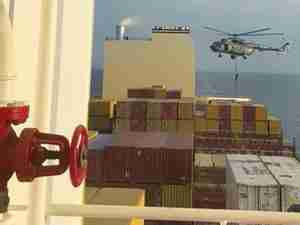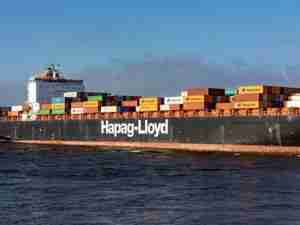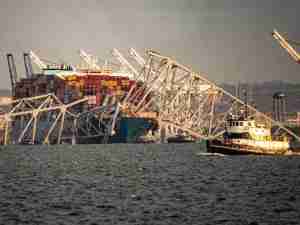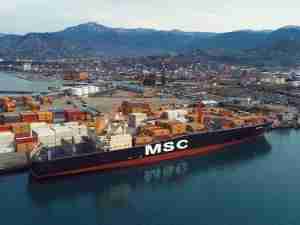By George Lauriat, Editor-in-Chief, AJOT
On April 26,, 1956 a cold drizzle was falling as the partially converted T-2 tanker Ideal X left Port Newark destined for Houston and maritime history books. Even to an untrained eye the Ideal X looked a bit unusual. A slotted spar deck was erected above the tanker's main deck to which were secured fifty-eight purposely-built 'boxes' that had been loaded by shore side cranes. It is doubtful that any of the onlookers, including the project's father, trucking magnate Malcom P. McLean, realized that this was the beginning of a transportation revolution. The hopes at that time were a little more modest. McLean wanted a more efficient system for moving freight on inter-coastal routes that would complement road and rail traffic. From McLean's point of view, the concept was always an intermodal one.
McLean had a special gift for reducing complex problems to bare essentials. Conventional freight carriage required a shipper to load a truck with goods. The over-the-road trailers would then have been unloaded in the transit shed of the terminal, and the individual packages would then have to be moved to a consolidation point before being taken to the side of the ship to be loaded aboard and stowed. This was a time consuming and labor intensive process. Although roll-on roll-off had been used during the World War II, it didn't fit the economic parameters that McLean envisioned. A standard 35 foot highway trailer might carry 41 tons of cargo measuring 40 c/ft. to the weight ton. But when mounted on the chassis, the space occupied was equivalent to about 94 measurement tons.
McLean's genius was reducing this process to simply moving the box, not the individual pieces of cargo. Although the containerization concept was brilliant in its simplicity, McLean had to literally invent the box before he could put his plan into action. McLean designed a new type of highway trailer. This new unit was a flat-bottomed box with sufficient vertical strength to withstand stacking and was longitudinally reinforced to enable it to be lifted by a crane.
The issue of building a ship to test the new concept was complicated by the fact that coastwise trades fell under the authority of the Interstate Commerce Commission (ICC). To speed the project along, McLean purchased the seven-ship fleet of the Pan Atlantic Steamship Company, a subsidiary of the Waterman Steamship Corporation, which already held valid certificates for operation in both the coastwise and intercoastal routes.
In an effort to maintain momentum, McLean decided to purchase four T-2 tankers for conversion, rather than using conventional stick ships, which would have been harder to adapt for his project. A half century ago the voyage of the Ideal X launched containerization revolution that completely transformed how goods are moved. Global shipping changed in what seemed to be the blink of eye. Containerships sprang from shipyards in ever increasing sizes. Around the world, container terminals flooded with acres of containers grew to accommodate the ever-larger ships. On highways and railroads today the ubiquitous box now travels scarcely noticed. It is as commonplace in Tokyo as it is in Topeka. This uniquely American innovation has changed the way the commercial world works.
What happened?
Yet for all this US-born innovation, what has happened to the US maritime enterprise in the ensuing years? In 1956, the US active privately-owned general cargo merchant fleet numbered 670 ships amounting to about 7.2 million dwt. Two decades later, the general cargo fleet was 300 ships of 5.1 million dwt. By 1996, the intermodal fleet was 123 ships of 3.6 million dwt









